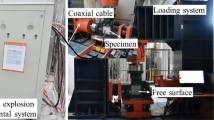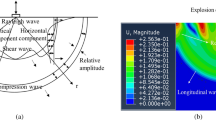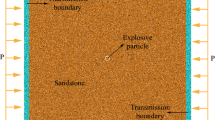Abstract
Blasting in high in situ stress fields is different from blasting at the earth’s surface because of the dynamic unloading effect in the former. In order to study the coupling of dynamic loading and dynamic unloading in the blasting process, the explicit finite element method and explicit-implicit finite element method are employed respectively to investigate the influence of high stress on blasting effects. The results show that the stress and strain change rules of the two methods are clearly different. The stress and strain change rates calculated by the explicit-implicit algorithm simulation are greater than the results simulated by the explicit finite algorithm. The radius of the blasting cavity calculated by the explicit-implicit finite element method is 0.015 m larger than that of the explicit finite element method. Based on the results of the explicit finite element method, a theoretical model is also established, which helps to clarify the effects of high in situ stress unloading when blasting in a high in situ stress field. The model shows that the maximum tensile radial displacement caused by high in situ stress dynamic unloading at the edge of the blasting cavity is 0.12 mm, and the dynamic unloading radial tensile effect can lead to rock failure. This research illustrates that high stress has a considerable influence on the blasting process and on rock-breaking effects. According to the findings, certain blasting engineering design suggestions are made.



















Similar content being viewed by others
References
Abdelmeguid M, Rowe RK, Lo KY (2003) Three-dimensional analysis of unlined tunnels in rock subjected to high horizontal stress. Can Geotech J 40(6):1208–1224
Bastante FG, Alejano L, González-Cao J (2012) Predicting the extent of blast-induced damage in rock masses. Int J Rock Mech Min 56(2):44–53
Cai M (2008) Influence of stress path on tunnel excavation response-numerical tool selection and modeling strategy. Tunn Undergr Space Technol 23(6):618–628
Cantieni L, Anagnostou G (2009) The effect of the stress path on squeezing behavior in tunneling[J]. Rock Mech Rock Eng 42(2):289–318
Cao W, Li X, Tao M, Zhou Z (2016) Vibrations induced by high initial stress release during underground excavations. Tunn Undergr Space Technol 53:78–95
Carter JP, Booker JR (1990) Sudden excavation of a long circular tunnel in elastic ground. Int J Rock Mech Min Sci Geomech Abstr 27(2):129–132
Cohen, AM (2007) Numerical methods for Laplace transform inversion. Springer
Cook MA, Cook UD, Clay RB (1966) Behavior of rock during blasting. 10:17–25
Fan Y, Lu W, Zhou Y (2016) Influence of tunneling methods on the strainburst characteristics during the excavation of deep rock masses. Eng Geol 201:85–95
Guo Y, Yang C, Mao H (2012) Mechanical properties of Jintan mine rock salt under complex stress paths. Int J Rock Mech Min Sci 56(12):54–61
Hagan TN (1979) Rock breakage by explosives. Acta Astronaut 6(3):329–340
Hamdi E, Romdhane NB, Lecléach JM (2010) A tensile damage model for rocks: application to blast induced damage assessment. Comput Geotech 38(5):133–141
He M, Xie H, Peng S, Jiang Y (2005) Study on rock mechanics in deep mining engineering. Chin J Rock Mech Eng 24(16):2083–2013 (in Chinese)
Hu Y, Lu W, Chen M, Yan P, Zhang Y (2015) Numerical simulation of the complete rock blasting response by SPH–DAM–FEM approach. Simul Model Pract Theory 56:55–68
Hua A, You M (2001) Rock failure due to energy release during unloading and application to underground rock burst control. Tunn Undergr Space Technol 16(3):241–246
Karekal S, Das R, Mosse L, Cleary PW (2011) Application of a mesh-free continuum method for simulation of rockcaving processes. Int J Rock Mech Min 48(2):703–711
Li X, Cao W, Zhou Z, Zou Y (2014) Influence of stress path on excavation unloading response. Tunn Undergr Space Technol 42(42):237–246
LSTC (2010) LS-DYNA keyword user’s manual, version 970. Livermore Software Technology Corporation, Livermore
Lu W, Yang J, Yan P, Chen M (2012) Dynamic response of rock mass induced by the transient release of in-situ stress. Int J Rock Mech Min Sci 53(9):129–141
Lucier AM, Zoback MD, Heesakkers V, Reches Z, Murphyd SK (2009) Constraining the far-field in situ stress state near a deep south African gold mine. Int J Rock Mech Min Sci 46(3):555–567
Miklowitz J (1960) Plane-stress unloading waves emanating from a suddenly punched hole in a stretched elastic plate. J Appl Mech 27(4):165
Ning Y, Yang J, Ma G, Chen P (2011) Modelling rock blasting considering explosion gas penetration using discontinuous deformation analysis. Rock Mech Rock Eng 44(1):483–490
Talbot A (1979) The accurate numerical inversion of Laplace transforms. IMA J Appl Math 23(1):97–120
Tao M, Li X, Wu C (2012) Characteristics of the unloading process of rocks under high initial stress. Comput Geotech 45(9):83–92
Tao M, Li X, Li D (2013a) Rock failure induced by dynamic unloading under 3D stress state. Theor Appl Fract Mech 65(3):47–54
Tao M, Li X, Wu C (2013b) 3D numerical model for dynamic loading-induced multiple fracture zones around underground cavity faces. Comput Geotech 54(10):33–45
Yan P, Lu W, Chen M, Hu Y, Zhuo C, Wu Z (2015) Contributions of in-situ stress transient redistribution to Blasting excavation damage zone of deep tunnels. Rock Mech Rock Eng 48(2):715–726
Acknowledgments
First of all, the authors give sincere acknowledgement to CAS Pioneer Hundred Talents Program for the completion of this research. The research presented in this paper was also jointly supported by the National Natural Science Foundation of China (Grant No. 41502334) and the 973 Program of China (Grant No. 51278397). The authors wish to acknowledge these financial contributions and convey their appreciation of these organizations for supporting this basic research.
Author information
Authors and Affiliations
Corresponding author
Rights and permissions
About this article
Cite this article
Xiao, SY., Su, LJ., Jiang, YJ. et al. Numerical analysis of hard rock blasting unloading effects in high in situ stress fields. Bull Eng Geol Environ 78, 867–875 (2019). https://doi.org/10.1007/s10064-017-1067-7
Received:
Accepted:
Published:
Issue Date:
DOI: https://doi.org/10.1007/s10064-017-1067-7




